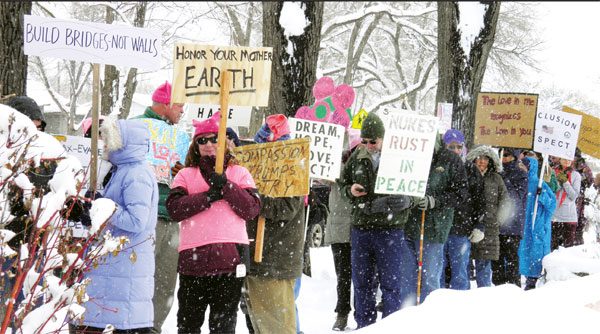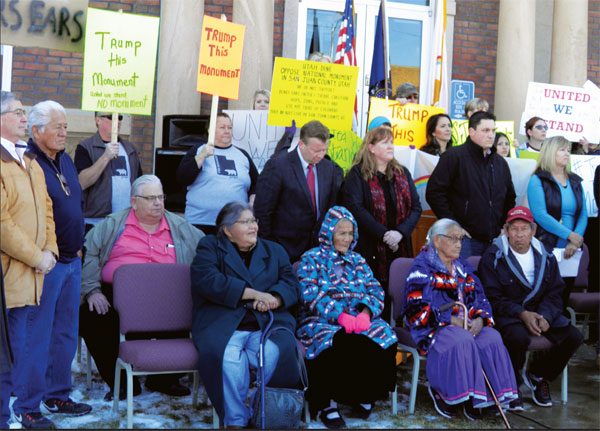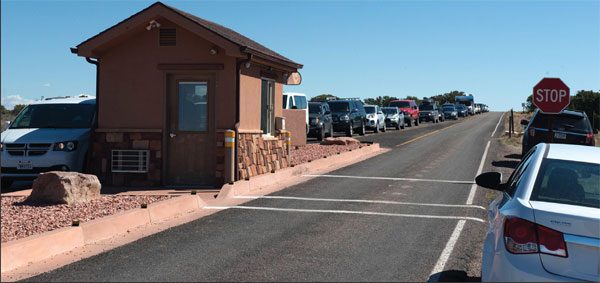
Marchers in Cortez joined protesters nationwide on the day after President Trump’s inauguration. Photo by Gail Binkly
2017 began in turmoil and ended the same way.
When Donald Trump took the reins of leadership from Barack Obama, it inaugurated a year that would be marked by marches and sign-waving, executive orders, litigation, and furious, partisan debate over the country’s new direction. And all of that was mirrored across the sprawling, diverse region known as the Four Corners.
Even as the rural, rightward-leaning people of the area hailed the election of a man they saw as a bold swamp-drainer, the vocal minority of progressives that also inhabits the area rose up in protest.
In January in Cortez, more than 500 people braved soggy snow to join with millions nationwide in the Women’s March the day after Trump was sworn in as commander in chief. It was the largest single-day protest in United States history. (The tally of 500-plus in Cortez wasn’t one of those loosey-goosey crowd estimates, either; it was verified by several people who counted as the marchers walked by.) It was a huge turnout by Cortez standards and it marked the beginning of a newly energized opposition to conservative policies, both locally and nationwide.
Protests would erupt periodically throughout the year in response to various actions by the new president.
But there were protests and rallies on the other side as well. In fact, the year was bracketed by two turnouts at the same site in San Juan County, Utah, which was home to a great deal of news in 2017.
‘Land grab’
The first protest actually took place two days before the start of the new year, when a crowd of more than 300 shivered in the wintry shade in front of the San Juan County courthouse in Monticello. Carrying signs that begged, “Trump this monument” and similar sentiments, they were there to protest Obama’s designation of a 1.35-millionacre national monument in their county.

Bears Ears National Monument was the subject of furious debate throughout the year. Here, local citizens protest President Obama’s designation of the monument during a gathering in Monticello, Utah. Photo by Gail Binkly.
Bears Ears would become famous nationwide, partly for its cutesy name, partly because it was hailed as the first Native American national monument (its original plan contains provisions for oversight by five tribes), and partly because it was viewed by opponents as a symbol of presidential overreach and federal heavy-handedness.
Rhetoric flew. Critics of the monument called it a “land grab,” ignoring the fact that the lands placed under monument protection were federal lands to start out with.
Later, when Trump declared in November that he was going to reduce Bears Ears to two separate parcels totaling just 220,000 acres, a reduction of 85 percent (if it stands up in court), opponents of that action would accuse him of a “land grab,” again ignoring the fact that the monument had never changed hands.
Since it was federal land before and after Obama’s proclamation, and federal after the downsizing, why did the issue of its being a monument create such a furor?
Locals feared the greater protections involved in a monument management would mean an end to many traditional uses of the rugged, little-known area, such as firewood-gathering, motorized travel, and natural-resource extraction.
The whole question of oil and gas drilling and/or hardrock mining on the monument, however, is cloaked in mystery. Some monument critics say the designation isn’t needed because there aren’t enough resources to bother with, that drilling and mining will never be issues and the greater danger lies in the hordes of tourists that will flood the pristine area as it becomes more publicized.
Jam-packed parks
That’s not an unreasonable concern, given the fact that Utah’s national parks are jam-packed, thanks in part to a massive advertising campaign. The final 2017 numbers aren’t in, but some 14.4 million people visited the state’s 13 national park units in 2016, up 21 percent over the year before. Visitation at Arches near Moab has doubled over the past decade.

A line of cars waiting to enter the Island in the Sky section of Canyonlands National Park. National-park crowding and lack of funding was a major issue in 2017. Photo courtesy National Park Service.
Ironically, many visitors were coming to experience nature, solitude, peace and quiet. Instead, they found lines of cars, crowded trails, and constant noise.
Despite the parks’ popularity, congressional Republicans have been slashing funding for the Park Service, and late last year the service proposed hiking the entrance fee in 17 of the most popular parks to $75 per car. Those parks include Grand Canyon in Arizona; and Bryce, Zion, Canyonlands and Arches in Southeast Utah.
The Park Service also slashed the number of free entrance days it offers, from 16 just two years ago down to four in 2018.
Future in limbo
But back to Bears Ears and the question of its resources. Some monument critics argue the exact opposite, that the designation is bad precisely because it precludes mineral extraction and that there ARE resources there ripe for the plucking. In May, the board of the San Juan School District passed a resolution opposing the monument, saying the designation will cost the district money because it won’t allow natural-resources development. San Juan County is Utah’s poorest county, and board Vice President Merri Shumway told the Free Press that every single student in the district qualifies for the federal lunch program, so every additional dollar is needed.
At the moment, the future of Bears Ears as a monument is very much in limbo. Three separate lawsuits have been filed challenging Trump’s move to shrink the monument boundaries, and there is a real question about whether a president has the legal authority, under the 1906 Antiquities Act, to make such alterations.
Clouds around coal
Natural-resource and environmental issues were big in 2017, and nowhere more so than in the Four Corners. The future of coal in general, and coal-fired power plants in particular, remains a major concern.
In June, in a highly controversial action, the Navajo Nation approved a two-year replacement lease for the Navajo Generating Station near Page, Ariz. The owners of the power plant had warned the Navajo government they would close it in December if a lease extension were not negotiated. The two-year extension meant continued employment for about 800 people at the plant and the Kayenta Coal Mine that feeds it.
But the plant, the biggest coal-fired plant in the West, emits the second-highest amount of visual pollutants nationwide and the seventh-highest amount of carbon dioxide. The Navajo Nation is still trying to prepare for the plant’s impending closure, which has only been delayed unless a new owner/operator can be found. Meanwhile, San Juan County, N.M., is preparing for the closure of another coal-fired plant, the San Juan Generating Station near Waterflow. In December, it shut down two of its four units, although legislators were trying to find a way to soften the economic blow of the closure.
Balancing act
The power-plant question is part of a larger issue that has long plagued the Four Corners – how to balance a clean environment with a robust economy. Many locals breathed a sigh of relief in recent years as lower oil prices slowed the pace of drilling, with its attendant noise, pollution, and traffic.
But county governments and others decried the loss of jobs and tax revenues.
The balancing act is involved in the whole issue of the methane rule, an Obama administration rule intended to force oil and gas operators on federal public lands to quit wasting methane, by making them capture and sell it instead of leaking, venting, or flaring it. (See the article here.)
Urged on by the energy industry, the Trump administration tried a number of ways to undo the rule. First it tried to have Congress overturn it, but that failed. Then the administration tried legal maneuvers to get around implementing the rule; as of press time, the matter was still being litigated.
Bye, bye MLP
As part of its relentless push to undo pretty much everything Obama put in place, the Trump administration announced that it plans to rescind a BLM “instruction memorandum” that provided for master leasing plans – specialized plans intended to offer focused oversight of energy development in particular areas.
The announcement appears to mean that the BLM will not be moving forward with a master leasing plan it had intended to create for 71,000 acres in Montezuma and La Plata counties. The MLP process had been approved by the state and national BLM offices following a lengthy public process in 2015 and 2016 in which the vast majority of individual comments supported an MLP.
The end of the MLP pleased the Montezuma County commissioners, who had steadfastly opposed its creation. They argued that the overarching management plan written by the BLM’s Tres Rios Field Office offers enough regulation of oil and gas drilling.
Budget squeeze
Their stance was motivated partly by a general dislike of federal land and the federal government, but also by concern about the county’s revenues, which have been hurt by two major factors.
One is a downturn in the production of carbon dioxide, which traditionally funds about half of the county’s property taxes. (CO2 production is tied to oil-drilling, so less drilling means less CO2 extraction.)
The other is an amendment to the state constitution called the Gallagher Amendment, which sets a ratio between residential and commercial property taxes that has the effect of keeping the former artificially low.
As Colorado’s Front Range booms with new houses, the rate at which residences are assessed keeps dropping, but not enough new homes are being built in rural areas to make up the lost tax revenues. Going into the budget process for 2018, Montezuma County faced a looming deficit of about $1.5 million. The commissioners and administration whittled that down to $475,000 through severe belt-tightening, and expected to make up the difference from their reserves.
‘No Nukes’
Controversy even swirled over hardrock mining. In 2017 the Four Corners region continue to debate the costs and lingering effects of 2015’s Gold King Mine disaster, in which 3 million gallons of toxic sludge from an abandoned gold mine in the Animas River watershed near Silverton, Colo., came spilling all the way into the San Juan River.

Environmental controversies abounded in the Four Corners in 2017. Here, marchers protest a possible license renewal for the White Mesa uranium mill in San Juan County, Utah. Photo by Gail Binkly.
And residents of San Juan County, Utah, argued over the future of the White Mesa uranium mill sitting just four miles north of the small Ute Mountain Ute tribal community of White Mesa.
In May, protesters marched north from the community, which is between the towns of Bluff and Blanding, to the mill site, on private land bordering Bears Ears National Monument (at least as it was originally configured under President Obama).
Carrying signs such as “Water Is Life” and “No Nukes,” they were protesting a proposed renewal of the mill’s radioactive- materials license, as well as an amendment to the license to allow the mill to process alternate feed material.
The Ute Mountain Ute Tribe and others are concerned about the mill’s proximity to their reservation. They say old tailings impoundments may leak and contaminate groundwater; they also raise concerns about airborne contaminants. But a 2014 lawsuit by the Grand Canyon Trust against the mill and its owner, Energy Fuels, over radon emissions was dismissed in September 2017.
Gerrymandering?
While Montezuma County dealt with budget woes, San Juan County, Utah, struggled with litigation in 2017. In December, a U.S. district judge upheld new voting-district boundaries for both the county commission and the San Juan School District.
The decision came after years of litigation between the county and the Navajo Nation, which had filed suit charging that the current districts were racially gerrymandered. Their main issue was with the three-member county commission, which since 1983 had been court-ordered to vote by district rather than at large.
Over the years, the commissioners left those districts intact even as the county’s population shifted and changed. They argued that they believed they weren’t allowed to change the boundaries, but the end result was that one commission district was more than 90 percent Navajo while the other two had white majorities, even though Native Americans by then constituted a slight majority countywide. That meant it was highly unlikely there would ever be more than a single Navajo on the commission. (Indians also have never held more than two seats on the five-member school board.)
In 2016, U.S. District Judge Robert Shelby ruled in favor of the Navajos and ordered the boundaries redrawn. When the county and Navajos couldn’t agree on new ones, the judge appointed an outside expert to redraw them, and his version became final. That is, barring any legal challenges by the county, which remained unhappy over the new districts because, for one thing, they divided Blanding and its surrounding area among all three districts.
The Navajo Nation hailed the decision. “We had Navajo communities in Utah whose voices were drowned out by district lines that did not represent the majority populations,” Vice President Jonathan Nez said in a release. “Now we have voting districts that better reflect reality.”
But although the decision could mean major political shakeups, as the county’s Navajos tend to be Democrats, it by no means guarantees that two Navajo commissioners will be seated. Historically, Native Americans have not turned out to the polls in high numbers, and regardless, it can’t be assumed that voters will always cast their ballots along racial lines.
Shelby ruled that the new districts will take effect for the election in November 2018 and also that new commissioners and school-board members must be chosen then, for staggered terms. It remains to be seen whether the ruling will mean a political upheaval in the traditionally conservative county, or whether the election will result in business as usual.
Water roller-coaster
Just as the region has suffered through booms and busts in energy development, it rides a roller-coaster in terms of precipitation. When 2017 began, the Four Corners was flush with water, reveling in the benefits of an El Niño year. Deep snowfall meant a springtime boating spill on the Lower Dolores River that was rare in its magnitude.
Recreationists flocked to enjoy a two-month-long (albeit on-and-off), 200,000-acre-foot release from McPhee Dam. Biologists measured the effects on three native fish species in the river and on the riparian corridor.
The passage of a year, however, has brought a stark contrast. At press time, the snowpack in the Dolores, San Juan, Animas and San Miguel river basins was at just 25 percent of normal and the weather was preturnaturally warm, with people in shirtsleeves and shorts strolling the streets of Cortez.
And even as locals remarked on how “nice” the sunshine was, they also wondered what it might portend in terms of drought and wildfire come summer.
But no one knows what 2018 will bring. About all that can be predicted with certainty is that there will be continued juicy times for journalists.

